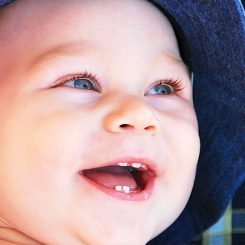
GROWING AND LOSING BABY TEETH are major milestones in your child’s development. If you’re a first-time parent, you probably have a lot of questions about what to expect, so let’s take a look at how baby teeth develop and when you can expect to start seeing them, as well as when adult teeth will start replacing them.
Baby Teeth Develop Before We’re Even Born!
Long before babies are even born, their teeth begin to develop in the gums, a process called odontogenesis. The tooth buds that will become baby teeth start forming by week six of pregnancy, then continue to grow until after the baby is born, ultimately pushing through the gums. Even then, the roots still have a bit of growing left to do.
They Don’t All Erupt At Once
Baby teeth tend to erupt in pairs, and these pairs tend to alternate between top and bottom teeth. The first pair, the lower central incisors, normally make their appearance after they reach between six to ten months of age. The next two are the upper central incisors between eight to twelve months. The lateral incisors come next, between nine and sixteen months. The first molars come next, then the canine teeth, and finally the second molars.
Most toddlers have their full set of twenty baby teeth by the time they turn three. Talk to us if you’re worried your child’s baby teeth aren’t growing in according to schedule, but there isn’t usually cause for concern unless no teeth have arrived by eighteen months. Whenever that first tooth does arrive, be sure to schedule an appointment!
It’s Time To Call the Tooth Fairy!
Normally, children begin losing baby teeth between ages five and six. Kids who take a little longer might feel left behind, because losing a tooth is a rite of passage and symbol of maturity. If no baby teeth are loose by the time they turn seven, it’s a good idea to talk to us about it. There isn’t usually anything to worry about; late-blooming adult teeth can actually be stronger and more cavity-resistant than they would’ve been if they arrived on schedule!
Fun Trivia: Natal Teeth And Folklore
In some (rare) cases, a baby might actually be born with one or two teeth. These are called natal teeth. They aren’t actually part of the regular set of baby teeth and typically are oddly shaped and have malformed roots, which makes them very loose. Doctors often remove them before new parents take their baby home from the hospital.
Even though natal teeth are perfectly harmless anomalies, over the centuries, different cultures have had a wide range of reactions to them. In China, they were considered bad luck, but in Europe, they were a mark that the child had a wonderful future ahead of them. Some Ural-Altaic tribes even viewed them as a sign that the child was a sorcerer!
Keep On Brushing!
No matter whether your child is a six-month-old with just one tooth or is a teenager with nearly a full set of adult teeth, all teeth always need to be cleaned and taken care of. Healthy brushing habits for baby teeth lead to healthy habits for adult teeth!
